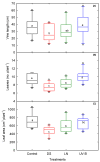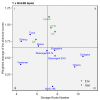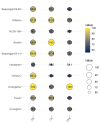Drought, Low Nitrogen Stress, and Ultraviolet-B Radiation Effects on Growth, Development, and Physiology of Sweetpotato Cultivars during Early Season
- PMID: 35052496
- PMCID: PMC8775168
- DOI: 10.3390/genes13010156
Drought, Low Nitrogen Stress, and Ultraviolet-B Radiation Effects on Growth, Development, and Physiology of Sweetpotato Cultivars during Early Season
Abstract
Drought, ultraviolet-B (UV-B), and nitrogen stress are significant constraints for sweetpotato productivity. Their impact on plant growth and development can be acute, resulting in low productivity. Identifying phenotypes that govern stress tolerance in sweetpotatoes is highly desirable to develop elite cultivars with better yield. Ten sweetpotato cultivars were grown under nonstress (100% replacement of evapotranspiration (ET)), drought-stress (50% replacement of ET), UV-B (10 kJ), and low-nitrogen (20% LN) conditions. Various shoot and root morphological, physiological, and gas-exchange traits were measured at the early stage of the crop growth to assess its performance and association with the storage root number. All three stress factors caused significant changes in the physiological and root- and shoot-related traits. Drought stress reduced most shoot developmental traits (29%) to maintain root growth. UV-B stress increased the accumulation of plant pigments and decreased the photosynthetic rate. Low-nitrogen treatment decreased shoot growth (11%) and increased the root traits (18%). The highly stable and productive cultivars under all four treatments were identified using multitrait stability index analysis and weighted average of absolute scores (WAASB) analyses. Further, based on the total stress response indices, 'Evangeline', 'O'Henry', and 'Beauregard B-14' were identified as vigorous under drought; 'Evangeline', 'Orleans', and 'Covington' under UV-B; and 'Bonita', 'Orleans', and 'Beauregard B-14' cultivars showed greater tolerance to low nitrogen. The cultivars 'Vardaman' and 'NC05-198' recorded a low tolerance index across stress treatments. This information could help determine which plant phenotypes are desirable under stress treatment for better productivity. The cultivars identified as tolerant, sensitive, and well-adapted within and across stress treatments can be used as source materials for abiotic stress tolerance breeding programs.
Keywords: aboveground parameters; gas exchange; nutrient deficiency; roots; solar radiation; transpiration efficiency; water stress.
Conflict of interest statement
The authors declare no conflict of interest.
Figures








References
-
- The US Sweetpotato Council . Sweet Potato Statistical Year Book: World Statistics. The US Sweetpotato Council; Dillsburg, PA, USA: 2020. pp. 1–62.
-
- Betty J.B. Evaluating sweet potato as an intervention food to prevent vitamin A deficiency. Compr. Rev. Food Sci. Food Saf. 2011;10:118–130.
-
- Allen J.C., Corbitt A.D., Maloney K.P., Butt M.S., Truong V.D. Glycemic index of sweet potato as affected by cooking methods. Open Nutr. J. 2012;6:1–11. doi: 10.2174/1874288201206010001. - DOI
-
- Fuglie K.O. Priorities for sweetpotato research in developing countries: Results of a survey. Hortic. Sci. 2007;42:1200–1206. doi: 10.21273/HORTSCI.42.5.1200. - DOI
-
- Asiedu R., Sartie A. Crops that feed the World. 1. Yams: Yams for income and food security. Food Secur. 2010;2:305–315. doi: 10.1007/s12571-010-0085-0. - DOI
Publication types
MeSH terms
Substances
LinkOut - more resources
Full Text Sources

